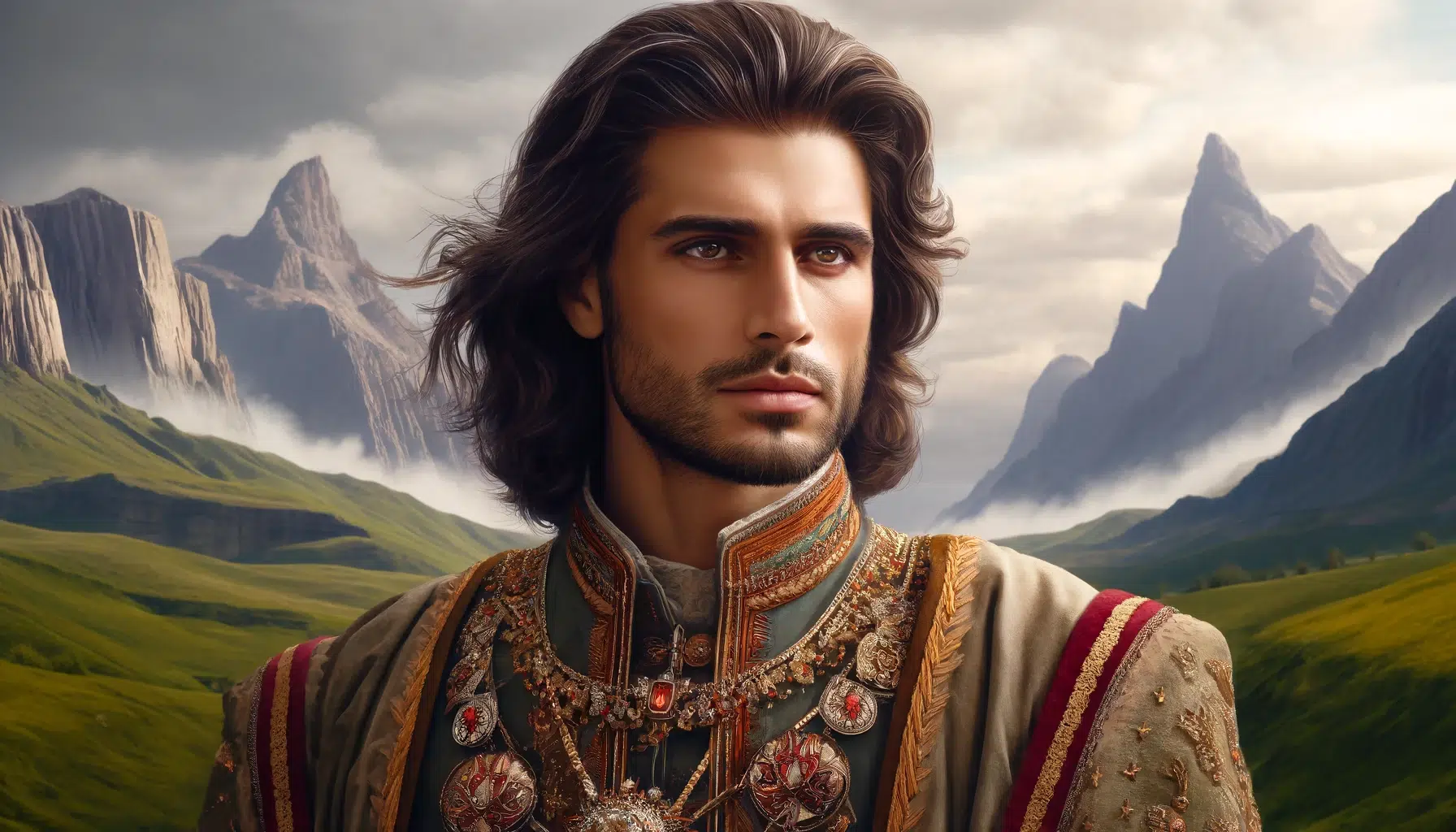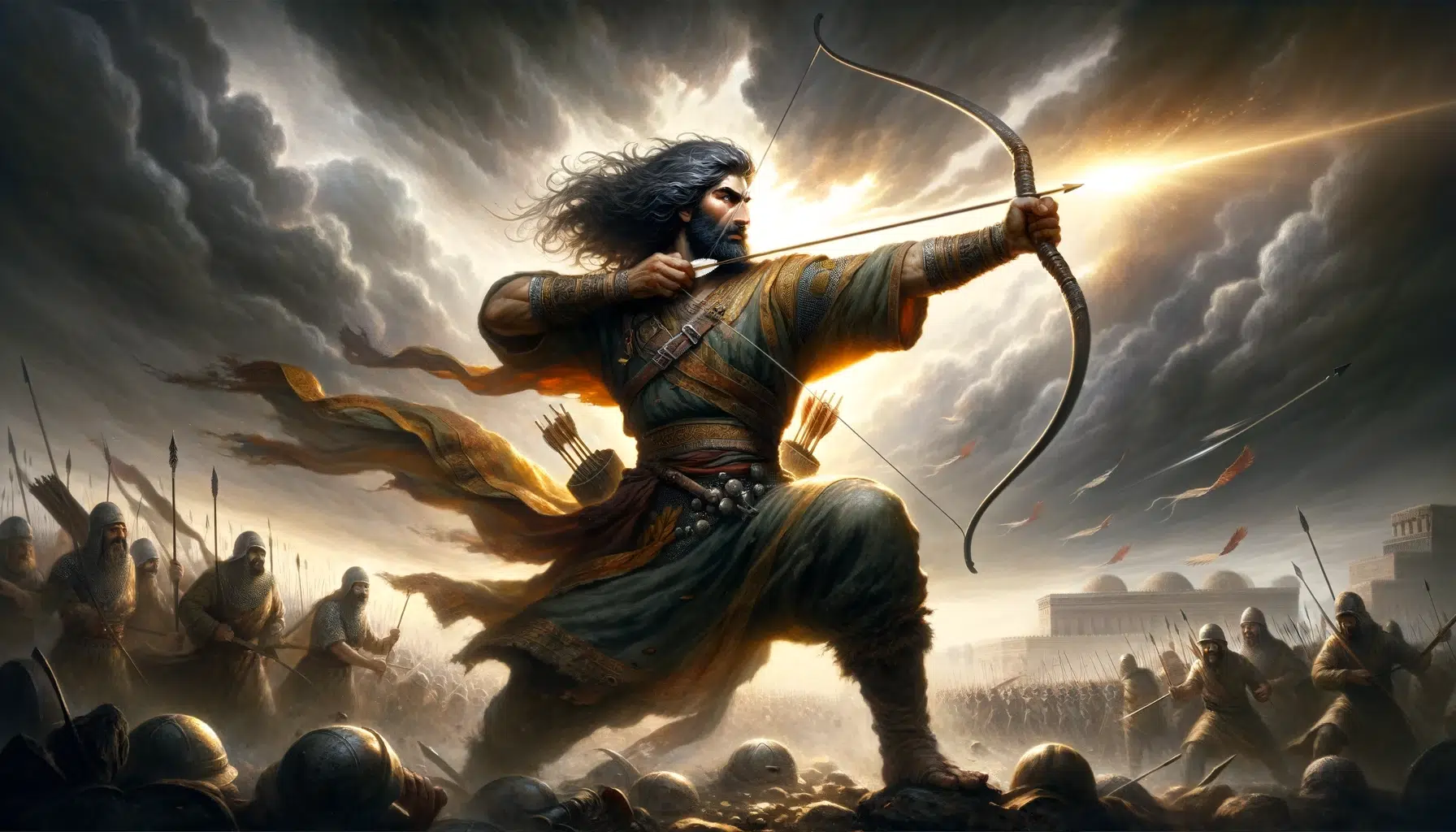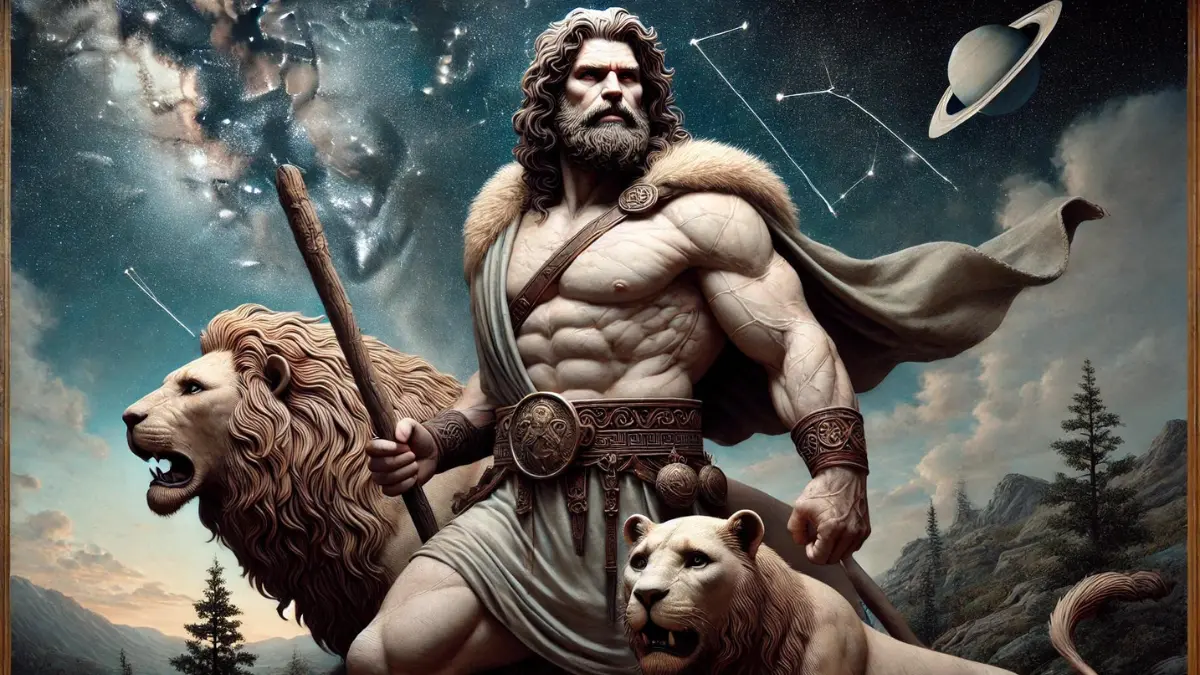
Hayk: Legendary Armenian Archer
Hayk is a key figure in Armenian mythology, called Hayk Nahapet. He is seen as the founding patriarch of Armenia.
Stories of Hayk show in detail in works like the “History of Armenia” by Moses of Chorene.
From the Armenian word ‘Hay,’ Hayk reflects Armenia’s national spirit.
Hayk is remembered as a cultural hero and forefather of Armenians. He was known as a giant archer and warrior who stood against the Babylonian king, Bel. This battle symbolizes Armenia’s struggle for independence.
Hayk’s lineage links Armenian legends with the Bible. According to ancient stories, Hayk is a great-great-grandson of Noah, which connects him to a famous family known from old tales.
These stories are a key part of Armenian culture being passed down through generations.
The Origins of Hayk

Hayk is a key figure in Armenian legends, known as Hayk Nahapet or “Hayk the Patriarch.”
He traces his roots to Noah’s son, Japheth.
From Japheth, the bloodline continued down to Hayk.
This shows the deep connection between the Armenian people and biblical history.
Hayk is famous for fighting the Babylonian king, Bel, standing up against tyranny.
Historians place this battle around 2492 BCE or 2107 BCE.
After this victory, Armenians called themselves “haykakan,” linking their identity to Hayk’s name.
Hayk’s descendants, including Aramaneak, continue his legacy as early Armenian leaders.
Moshe of Chorene documents this line of descendants.
Hayk is not just a historical icon but a mythic figure, reflecting qualities of ancient gods.
Descendants of Hayk

Hayk’s son, Aramaneak, inherits his father’s leadership qualities and courage, continuing the tradition of strong guidance.
He plays a critical role in consolidating the community and strengthening its foundations.
Among Hayk’s grandsons, Cadmus, also known as Kadmos, is notable for his wisdom and strategic insights.
He helps guide the community through challenging times, ensuring their safety and prosperity.
Another grandson, Aramenak, is celebrated for his strength and heroism, embodying the warrior spirit of his grandfather.
Aramayis, a direct descendant, gains recognition for his knowledge and leadership. His ability to lead and advise helps the community navigate both internal and external challenges.
Amasya, known for his architectural skills, contributes to the community by building important structures that serve both practical and ceremonial purposes.
Gegham, another descendant, connects deeply with nature, particularly mountains, which becomes a significant aspect of his identity and leadership.
Harma stands out for his loyalty and dedication, traits that solidify the internal unity of the group.
King Aram, an essential figure in the lineage, is known for his fairness and just leadership. His governance ensures peace and stability, reflecting the values passed down from Hayk.
In Armenian mythology he was the slayer of the giant Barsamin, and believed to be a war god, Aremenius, Father of Ara.
Lastly, Armenian King Ara the Handsome, known for his striking appearance, and his conflict with Queen Shamiram.
They would establish dynasties, ruled over territories, and contributed to the growth and development of Armenia.
The Legend of Hayk

In Armenian history and folklore, the legend of Hayk stands as a testament to courage, defiance, and the triumph of good over evil.
Hayk stands as a towering figure in Armenian legends, celebrated both as a leader and the founder of the Armenian nation.
Tales recount Hayk’s battles against the tyrannical Babylonian king Bel and the establishment of the village of Haykashen.
This is a testament to his strength, resilience, and determination.
The village became a symbol of hope and a sanctuary.
This is where Hayk and his descendants would build their legacy and the foundation of the Armenian nation.
The Legend of Hayk continues to resonate in Armenian culture, serving as a source of inspiration and national pride.
It emphasizes the power of individuals to defy oppression and uphold their values, ultimately shaping the course of history.
Hayk’s Conflict with the Babylonian King Bel

The story of Hayk and his battle against the Babylonian King Bel is key in Armenian mythology.
Hayk, a big man, is a great shot with a bow, and bold in war.
Hayk’s major conflict with the Babylonian king Bel showcases his role as a defender of his people’s freedom.
Bel, as a self-proclaimed god, demands unwavering worship and obedience from all under his rule.
King Bel wants to expand his power and tries to bring Hayk’s lands under his control.
This does not sit well with Hayk, who values independence above all else.
In a clash of beliefs and values, Hayk vehemently rejects the notion of idolizing a mortal ruler and steadfastly defies Bel’s authority.
The fight between them became legendary.
Hayk wins by making an amazing shot that becomes a story of Armenian courage and freedom.
This battle is a key event in the Armenian calendar.
It remembers Hayk’s win as a sign of strength against enemies of freedom.
Historian Moses of Chorene, also known as Movses Khorenatsi, wrote the story of Hayk and Bel in his “History of Armenia.”
He shows how their fight symbolizes an important part of Armenian history.
For Khorenatsi, Hayk’s win leads to a place called Haykashen.
This settlement marks the lasting influence of Hayk on Armenian heritage.
Hayk’s Archery Skills and Notable Achievements

Hayk’s archery skills are truly remarkable, making him a highly skilled archer and a force to be reckoned with on the battlefield.
His mastery of the bow and arrow played a pivotal role in his notable achievements throughout his life.
One of Hayk’s most important achievements is his victory over Bel, the Babylonian king.
With a poised arrow and unwavering aim, Hayk delivers a fateful shot that struck true, resulting in the defeat of Bel.
This victory solidifies Hayk’s legacy as a legendary archer and marks a significant turning point in his journey.
Throughout his battles and skirmishes, Hayk’s precise and powerful arrow shots consistently demonstrate his unrivaled archery skills.
His ability to hit targets with unmatched accuracy made him a formidable opponent and inspired awe among his allies and enemies alike.
Hayk’s archery skills elevate him to a legendary status, solidifying his place as one of the most revered figures in Armenian history.
His precise arrow shots and notable achievements continue to inspire and captivate the imagination of those who hear his story.
The Cultural Significance of Hayk

Hayk is a key figure in Armenian history and myth.
Moses of Chorene’s story tells how Hayk moves north with his people.
This journey leads to the founding of Haykashen village.
Soon, this becomes a crucial part of what makes Armenians who they are.
He is seen as a hero of culture, representing freedom and strength.
Hayk famously fought and beat the Babylonian King Bel.
Using Bel’s own bow against him was a powerful message.
It highlights themes of freedom and the need for self-rule, which are key parts of the Armenian story.
But Hayk’s impact goes far beyond his battle stories.
The names of the Armenian people, like Haykazun or Haykazn, come from his name.
These names show a deep connection to their history and a strong sense of pride.
Hayk’s story is similar to myths of Asshur for the Assyrians.
He has links to the Orion constellation in the Armenian Bible.
Also, he shares similarities with Hindu god Rudra.
These connections show a deeper, almost spiritual bond between Hayk and the Armenians.
Hayk’s tale isn’t just a story from the past; it’s a symbol of Armenian strength and cultural unity.
His memory brings Armenians together with a shared sense of history and pride in their identity.
This would last for centuries and continues to shape and inspire the Armenian people today.
Learn more about:
Hayk’s Legacy in Armenian Mythology

Hayk’s story in Armenian myths goes far beyond his own life. It makes him a central figure in their folklore.
Directly after him comes Armenak. This tradition continues without break, featuring notable figures like Aramais.
Aramais would start the town of Aramavir. Later, this town was renamed Armavir, showing its lasting importance.
Armenian mythology tells stories about the land’s names, too.
Shirak would take the name after Shara, Aramais’s son.
And Mount Ararat, now known as “Masis,” comes from Amasa, Shara’s son.
These stories help keep the nation’s history alive, strengthening its cultural identity.
Moses of Chorene, a respected historian, writes about a saying linked to Shara.
This shows that Armenian myths would be valued even in later, Christian, times.
They reflect deep thoughts about the world and people.
People often compare Hayk to the Greek god Orion.
Many honour him not only as an archer but also as the founding leader of the Armenians.
Armenia’s name (Hayastan) comes from him, tying him to the nation’s deep identity.
Other figures like Vahagn the Dragonkiller add rich layers to Armenian mythology.
They shape stories that capture the spirit of the nation.
The term “Vipasank” portrays key moments in Armenian history.
It includes the creation of the nation and its kingdoms.
The historian Movses Khorenatsi played a key part in keeping these stories alive.
Tigran the Great and tales of King Artashes are examples of important victories and myths.
Learn more about Greek mythology:
Armenians Stayed in the Region
Studies of the Armenian people’s DNA support their long history in the region.
They show little mixing with other genetic groups since 13th century BC.
Modern Armenians have close links to the ancient peoples of the region, forming a unique genetic group.
Armenians share connections with farming cultures of the past, like the Neolithic Europeans.
A big part of Armenian DNA comes from these European farmers.
The Armenian people have stayed relatively genetically pure for over 3,000 years.
This shows how closely their heritage has been guarded.
Monuments and Memorials to Hayk

Armenia shows great respect for Hayk through monuments and memorials all over the country.
The statue of Hayk in Yerevan is especially important.
It stands tall as a symbol of Armenian culture, representing their deep roots and historical heritage.
There are also other statues and landmarks dedicated to Hayk.
They remind Armenians of their long history and heritage.
Hayk is often shown with his bow, a hero fighting for freedom against the king of Babylon.
This image connects Armenians to their past and builds their identity.
Adding such historical markers across Armenia is a promise to keep their stories alive.
These monuments not only teach people about Armenia’s past but also make Armenians proud.
They highlight Hayk’s everlasting impact, mixing history with cultural pride, inspiring everyone who sees them.
Conclusion
Hayk, the legendary Armenian archer, occupies a significant place in Armenian history and culture.
His tale of unwavering defiance, remarkable courage, and extraordinary archery skills continues to resonate with Armenians, instilling a sense of national pride.
The enduring impact of Hayk’s legend is evident in his illustrious lineage, the establishment of Haykashen, and the rich cultural heritage surrounding his narrative.
Hayk’s legacy stands as a testament to the indomitable spirit and resilience of the Armenian people.
His story serves as a guiding light, inspiring generations to embrace their heritage and celebrate their collective identity.
Through his courageous feats and battles, Hayk embodies the unyielding determination of the Armenian nation.
For centuries, Hayk’s legend has been passed down from one generation to another, shaping the cultural fabric of Armenia.
The tale of this legendary archer transcends time, preserving the storied history and ancient traditions of the Armenian people.
Hayk’s legacy is a testament to the enduring power of cultural heritage and its ability to unite, inspire, and preserve a nation’s proud legacy.





